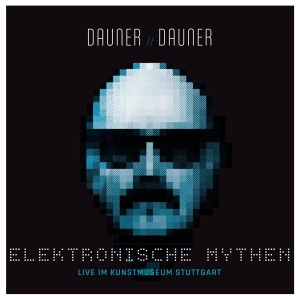Shortdescription:
Too early? Too late? Just at the right time! There was a time when making wishes used to help. “I was always either ahead of my time in music, which was not always a good thing, or certain events just happened too late, so that I [...]
*
Shipping time: 3-4 Days
|

|
Productsdescription:Too early? Too late? Just at the right time! There was a time when making wishes used to help. “I was always either ahead of my time in music, which was not always a good thing, or certain events just happened too late, so that I couldn’t use them creatively as I would have liked to.” This dry and – on closer examination – somewhat mysterious comment which appears out of the blue in the chapter called “Prizes and Scholarship” in “The Burning Piano“, Wolfgang Schorlau‘s biography of Wolfgang Dauner, can come to mind as we listen to the live recording “Electronic Myths” made at Stuttgart Art Museum on October 20, 2015. As many people well know, around 1970 Wolfgang Dauner, like Richard Teitelbaum, Paul Bley or Sun Ra, was one of the up-and-coming international jazz pioneers doing experimental musical research with electronic keyboards. Very early on, Dauner became the proud owner of a monstrously heavy Synthi 100 which ensured him encounters with inquisitive customs officials and later on with curious fellow musicians including Keith Emerson, Joe Zawinul and Wayne Shorter. They were exciting years, when Miles Davis used to drive through New York in an open sports car listening to Stockhausen’s tape manipulations, and when Kraftwerk and Can in Düsseldorf and Cologne developed their own special style of Kraut rock. Experimentation with electronic music, and research into all its possibilities, were very exciting, but could be extremely frustrating too, especially under live conditions. Konrad Heidkamp could confirm this experience: he summed up his experiences of experimenting together with Paul Bley and Annette Peacock: “There were no instructions, no one who could help you to find the different sounds and effects.” Trial and error, knob for knob, control for control, a million possible variations. Plus there was the problem that the Moog had no memory, so that each musical step had to be noted down and set up again in the same constellation for the performance – based on the design plan. That could take up to a quarter of an hour at a performance. So it was no wonder that creative musicians were not happy for very long, faced with these adverse conditions, no matter how exciting the experiments had been under private studio conditions. In the years that followed, electronic avant-garde, jazz and progressive rock music parted ways again. What remained were recordings in the archives which recalled the spirit of optimism of the times, and possibly promises not kept.
Wasn’t the “Dauner // Dauner” album, which Wolfgang Dauner produced in 2013 together with his son Flo, a clear indication that the archive material still holds great attraction? In “Electronic Myths”, Wolfgang Dauner transformed this retro-futuristic attraction into a decidedly creative impulse. The enterprise was not without hazards, considering that the synthesizer experiments around 1970 sound as remote to us today as Glenn Miller’s big band music must have sounded back in 1970. Anyone who, with a slight sense of confusion, has followed the mushy self-conservation of the group Kraftwerk in recent years will understand what cultural theorist Mark Fisher meant when he wrote: “What really makes nostalgia so unbearable is the widespread tendency to overestimate the past.” Wolfgang Dauner avoids this »nostalgia trap« by connecting his electronic studies of the late 1970s to the here-and-now and testing them for sustainability. He does this both seriously and with a dash of humor. The archive material bears witness to a historic love of experimentation, but in the course of the three-quarters of an hour of “Electronic Myths” he improvises with and to this archive material. What happens is a form of live overpainting of Dauner’s own archive material by electronic and acoustic means, which changes as a result. The fact that a few artistic stations are visited in the course of “Electronic Myths” (Weather Report with bass played by Jaco Pastorious; George Duke; Santana‘s “Welcome”; Bob James’s “Fourth World“) and also a few dead ends of musical history – and that he sometimes heads for imaginary folk music or classical music, or that he morphs percussive reduction, a truly sickly-sweet ambience, muscular fusion or functional dance floor music – is part of the whole idea. In order that this unusual journey through time did not become too abstract or demanding for the listener of today, Wolfgang and Flo Dauner included a few relaxing sections within the drama, where the listener can lean back a little in order to enjoy the astonishingly transparent overall sound before the next about-turn happens. None the less, the song format consistently took second place to a musical drift with a huge dramatic span. All in all, one could say that in “Electronic Myths”, the aim was not so much to take a nostalgic and rather sentimental look back at the options of experimenting with electronic equipment which were and were not realized historically; rather, it was a case of setting a historically informed impulse, viewed from today’s perspective, at the interface of improvisation and new music. This impulse remains open, contradictory and tricky, and does not offer itself easily to today’s listeners, which honors Wolfgang and Flo Dauner. The fact that Wolfgang Dauner undertook such research when approaching his 80th birthday speaks volumes. Ulrich Kriest (music critic)










